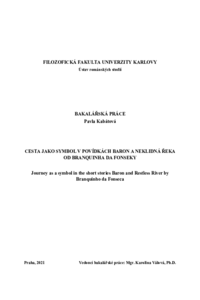Cesta jako symbol v povídkách Baron a Neklidná řeka od Branquinha da Fonseky
Symbol of the path in Branquinho da Fonseca's short stories O Barão and Rio Turvo
bakalářská práce (OBHÁJENO)

Zobrazit/
Trvalý odkaz
http://hdl.handle.net/20.500.11956/136659Identifikátory
SIS: 228997
Kolekce
- Kvalifikační práce [23212]
Autor
Vedoucí práce
Oponent práce
Grauová, Šárka
Fakulta / součást
Filozofická fakulta
Obor
Hispanistika - Portugalistika
Katedra / ústav / klinika
Ústav románských studií
Datum obhajoby
23. 6. 2021
Nakladatel
Univerzita Karlova, Filozofická fakultaJazyk
Čeština
Známka
Výborně
Klíčová slova (česky)
cesta|portugalský modernismus|Presença|Branquinho da Fonseca|PutováníKlíčová slova (anglicky)
Presença|Branquinho da Fonseca|Journey|Wandering|Portugese modernismBakalářská práce se zabývá symbolem cesty v povídkách "Neklidná řeka" (Rio Turvo, 1945) a "Baron" (O Barão, 1942), jejichž autorem je Branquinho da Fonseca, portugalský spisovatel, kterého řadíme k druhé generaci modernistů spjaté s časopisem Přítomnost (Presença). V povídce "Neklidná řeka" se Topograf vydává za svou novou prací na neznámý nepříliš obydlený poloostrov, v povídce "Baron" cestuje školní Inspektor do odlehlého pohoří Barroso. Protagonisté se vydávají na fyzickou pouť, která se shodně hned v úvodu stane neobyčejnou a tajemnou. Prožívají setkání s mimořádnými lidmi, která navždy mění jejich pohled nejen na svět, ale především na vlastní život. Putování se postupně mění na cestu duchovní či iniciační. Klíčová slova Portugalský modernismus, Presença, Branquinho da Fonseca, cesta, putování
The bachelor's thesis deals with the symbol of the journey in the short stories "Restless River" (Rio Turvo, 1942) and "Baron" (O Barão, 1942), authored by Branquinho da Fonseca, a Portuguese writer who is part of the second generation of Portuguese modernists associated with the magazine Presença. In the short story "Restless River", the Topographer sets out on his new work on an unknown, not very populated peninsula, and in the short story "Baron", a school Inspector travels to the remote Barroso Mountains. Both protagonists embark on a physical pilgrimage, which becomes unusual and mysterious at the very beginning. They experience encounters with extraordinary people, which forever change their view of not only the world, but above all their own lives. The journey gradually changes into a spiritual either initiating path. Key words Portuguese modernism, Presença, Branquinho da Fonseca, journey, wandering
